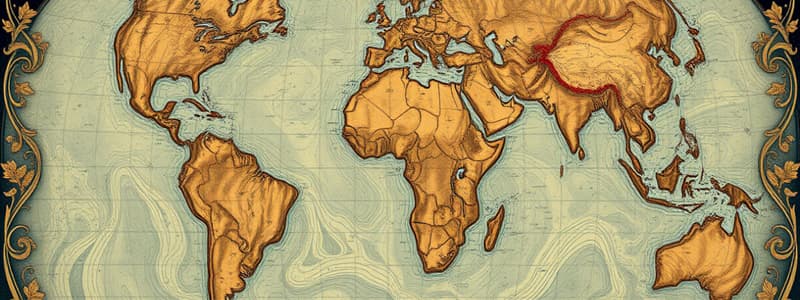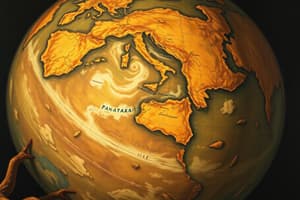Podcast
Questions and Answers
What was the name of the single ocean that surrounded Pangaea?
What was the name of the single ocean that surrounded Pangaea?
- Pacific Ocean
- Atlantic Ocean
- Panthalassa (correct)
- Indian Ocean
Pangaea was formed between 320 million and 195 million years ago.
Pangaea was formed between 320 million and 195 million years ago.
True (A)
Who proposed the notion of the ancient supercontinent Pangaea?
Who proposed the notion of the ancient supercontinent Pangaea?
Alfred Wegener
The theory that explains the movement of Earth's outer shell is known as __________.
The theory that explains the movement of Earth's outer shell is known as __________.
Which supercontinent existed before Pangaea?
Which supercontinent existed before Pangaea?
Match the following supercontinents with their order of existence:
Match the following supercontinents with their order of existence:
The formation and breakup of supercontinents have had little impact on Earth's history.
The formation and breakup of supercontinents have had little impact on Earth's history.
What geological evidence supports the idea that continents were once a single landmass?
What geological evidence supports the idea that continents were once a single landmass?
Flashcards are hidden until you start studying
Study Notes
Pangaea and Its Formation
- Pangaea was a supercontinent that existed from approximately 320 million to 195 million years ago.
- It was surrounded by a single ocean known as Panthalassa, contrasting with today's seven individual continents.
- The concept of Pangaea contributes to the modern theory of plate tectonics, which explains Earth's outer shell is divided into sliding plates over the mantle.
Geological Context
- Earth's geological history spans 4.5 billion years, witnessing multiple supercontinent formations and breakups.
- Supercontinent cycles are driven by the circulation within the Earth's mantle, which accounts for around 84% of the planet's volume.
Impact on Earth's Evolution
- The formation and breakup of supercontinents significantly influenced the planet’s evolutionary history.
- Brendan Murphy, a geology professor, emphasizes that these geological processes serve as the primary force driving Earth's evolution over time.
Preceding Supercontinents
- Pangaea is the most recent supercontinent; it followed earlier supercontinents like Rodinia and Columbia (Nuna).
- Gondwana, a large landmass that existed prior to Pangaea, remains debated regarding its classification as a supercontinent.
Alfred Wegener's Hypothesis
- Alfred Wegener proposed the existence of Pangaea over a century ago, supported by various geological evidence.
- Notable evidence includes the fitting shapes of continents, likened to a "tongue and groove" system.
Geological Evidence Supporting Pangaea
- Geologic records feature coal deposits in Pennsylvania similar to those in Europe (Poland, Great Britain, and Germany), indicating past land connectivity.
- The alignment of magnetic minerals in sediment layers shows historical migrations of Earth’s magnetic poles.
Fossil and Mountain Chain Correlation
- Identical fossils, like the extinct seed fern Glossopteris, are found across continents that are now widely separated, suggesting these landmasses were once connected.
- Mountain ranges, such as the Appalachians in the U.S. and the Atlas Mountains in North Africa, were formed from the collision of Gondwana and Laurussia, highlighting shared geological histories.
Studying That Suits You
Use AI to generate personalized quizzes and flashcards to suit your learning preferences.




